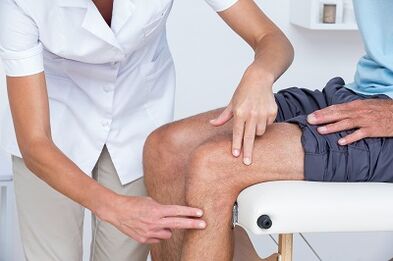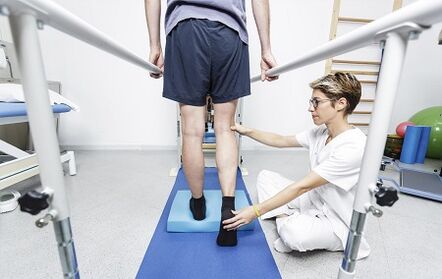Knee joint arthrosis is a chronic (long -term) degenerative disease that causes the cartilage destruction in the joints.Symptoms include pain, stiffness and swelling.Treatment options to reduce pain and disability include lifestyle changes (diet, physical exercise), physical and professional methods of treatment, medication and surgery.
Osteoarthrosis of the knee joint
Knee osteoarthrosis is a common disease, accompanied by chronic, exhausting pain.Recent clinical data showed that central sensitization stimulates the deformation of the knee joint osteoarthrosis.An improved understanding of how knee joint arthritis affects central pain processing is essential for identifying new analgesic goals/new therapeutic strategies.
Inhibitory receptors weaken the function of peripheral immune cells and modulate central neuro-immense responses.The systemic introduction of the receptor agonist weakened the behavior of pain caused by OA and changes in circulating and anti-inflammatory cytokines were manifested in this model.
Deformity of arthrosis
The deforming arthrosis of the knee joint is inflammation and the coating of the cartilage in the bones that form the knee joint (osteo = bone, arthro = itis = inflammation).The diagnosis of knee -joint osteoarthritis is based on two main results: radiographic data on changes in bone health (using medical images, such as X -rays and MRRI magnetic resonance imaging), and human symptoms.About 14 million people have symptomatic knee arthritis.Although the most common in older people, 2 million of 14 million people with a symptomatic knee OA were younger than 45 during the diagnosis, and more than half were younger than 65 years old.
Osteoarthritis (knee OA) is a progressive disease caused by inflammation and degeneration of the knee joint, which over time worsens.
Kjo prek të gjithë bashkimin, përfshirë kockat, kërcin, ligamentet dhe muskujt.Its development is affected by age, body mass index (BMI), bone structure, genetics, muscle strength and level of activity.Knee OA gjithashtu mund të zhvillohet si gjendje dytësore pas dëmtimit të gjurit.Depending on the phase of the disease and the presence of injuries or related conditions, the OA knee can be controlled using physical therapy.The most severe or enlarged cases may require surgical intervention.
Symptoms
People who develop knee OA can undergo a wide range of symptoms and restrictions based on the development of the disease.Pain occurs when the cartilage covering the knee joint bones to wear.The areas where the cartilage jumps or damages, expose the bone on the basis.The bone effect allows you to increase the stress and compression of the cartilage, and sometimes bone contact when moving, which can cause pain.Since the knee is a joint, the level of activity, the level of activity, and the type and duration of actions, as a rule, have a direct effect on symptoms.Symptoms can be exacerbated by weight activity, for example, when walking with a severe object.

Knee joint symptoms may include:
- Deterioration of pain during or after surgery, especially when walking, climbing, walking down the stairs or moving from a landing to a standing position.
- Pain or stiffness after sitting with a bent or straight knee for a long period of time.Pain is the most common symptom of osteoarthritis.As the disease develops and inflammation, the pain can become constant.
- A feeling of throwing out, cracking or grinding when moving the knee.
- Swelling after action.
- The stiffness of the affected knot was often seen first of all in the morning and after rest.
- Edema, which is sometimes warm for touch, can be visible in coupling with arthritis.
- Deformation can occur with osteoarthritis due to bone growth and cartilage loss.Bone growth in the end joints of the fingers is called the Hyberden joints.The bush joints are the growth of the bones in the middle finger joints.The degeneration of the cartilage of the knee joint can lead to the outer bending of the knees (foot-foot).
- A cracking sound or an iron sensation can be observed when the arthritis moves.This is caused by wiping bone against bone or rough cartilage.
Usually these symptoms do not arise suddenly and all immediately, but gradually develop over time.Sometimes people do not admit that they have osteoarthritis because they cannot remember a certain time or injury that caused their symptoms.If the knee pain has worsened for several months, which does not respond to rest or change in activity, it is best to seek advice for a medical employee.
Troubleshooting
Osteoarthritis can often be diagnosed by its characteristic symptoms of pain, reduced movement and/or deformity.Osteoarthritis can be confirmed by the X-Ray or MRI scan.General data include narrowing of the articular space between bone, cartilage loss and bone stimulation or bone growth.Blood tests can be used to rule out other possible conditions, but they may not diagnose osteoarthritis.

In the knee OA, 2 primary process is diagnosed.The first is based on a report on symptoms and clinical examination.The physiotherapist will ask questions about medical history and activity.The therapist will perform a physical examination to measure the movement of the knee (range of movement), strength, mobility and flexibility.They can also require different movements to see, increase or decrease the pain.
The second tool used to diagnose the knee joint is a diagnostic visualization.The physiotherapist can send to the doctor who will prescribe the X -knee rays in different positions to check the damage to the bone and cartilage of the knee joint.
If more serious joint damage is suspected, you can order an MRI in order to study more carefully with the overall status of articular and surrounding fabrics.
Blood tests can also be ordered to help exclude other conditions that can cause symptoms similar to knee osteoarthritis.
Treatment
Depending on the severity of the arthritis and the age of the patient, it will be chosen on how to treat arthrosis of the knee joints.Treatment may consist of operational or conservative methods, or their combinations.
The first line of treatment of knee joint arthritis involves modifying activity, anti -inflammatory drugs and weight loss.
Rejecting actions that improve pain can make this condition acceptable to some people.Anti -inflammatory drugs help alleviate inflammation that can contribute to pain.
Physical therapy to strengthen the muscles around the knee can help absorb a part of the given shock in the joints.This is especially true for arthritis with a knee cup (patello-femoral).Special types of brakes designed to transfer the load to the knee joint, which is less than arthritis, can also relieve pain.Drug injections inside the knee joint can also help temporarily.
In addition, walking with a cane on the opposite side, as a painful knee can help distribute part of the load, reduces pain.Finally, weight loss helps to reduce the strength passing through the knee joint.Combining these conservative measures can help relieve pain and prevent disability.
If these methods do not allow you to make the tolerant condition, surgery may be the best option for treating knee joint arthritis.The exact type of operation depends on age, anatomy and main condition.Some examples of surgical options for the treatment of arthritis include osteotomy, which consists of cutting bone to approximate the joint.
Modern methods of treatment of knee joint arthrosis include osteotomy, which is a good alternative if the patient is new and arthritis is limited by an area of the knee joint.This allows the surgeon to rebuild the knee in order to discharge the arthritis area and perform relatively non -part load included the knee joint.For example, the patient can be rebuilt to redistribute the load through the joint.The advantage of this type of surgery is that the patient's knee joint is preserved and can potentially provide many years of pain relief without prosthetic knee deficiencies.The disadvantages include a longer course of rehabilitation and the possibility of developing arthritis at a recent level knee.
The surgery to replace the knee joint involves cutting the arthritis and inserting the prosthetic joint.All arthritis surfaces have been replaced, including the femur, the lower foot cup and the knee.Arthritis surfaces are removed, and the ends of the bone are replaced by a prosthesis.The prosthetic component is usually made of metal and plastic surfaces, which are designed for smooth sliding against one another.
The replacement of the knee joint
The general surgery to replace the knee joint was first performed in 1968 and over the years evolved in a reliable and effective way to get rid of the pain when turning off and allows patients to resume their active lives.Improvements in the field of surgical methods and implants helped to make this one of the most successful orthopedic procedures today.As the population becomes older and remains more active, the need for a general knee replacement continues to increase.Many of the operations to replace the knee joint took place at the Special Surgery Hospital.Improvements in surgical technology and the design of new implants are some of the contributions that surgeons have made.
People often ask when and why should they replace their knee.This is an individual question that depends on the level of human activity and functional needs.Many people with arthritis live with pain, which prevents them from participating in activities;Others are so weakened that it is difficult for them to wear shoes and socks.A complete replacement of the knee joint offers the solution to the arthrosis problem and is performed in order to relieve pain and resume activity.After rehabilitation from successful complete replacement of the knee joint, the patient can expect surgery, without pain.A complete replacement of the knee joint significantly improves the patient's condition, and significantly reduces his or her long -term treatment costs.This study showed that not only the overall replacement of the knee joint is economically effective, but it also provides greater functionality and the best quality of life.
A complete replacement of the knee joint is considered a major operation, and the solution is not irrelevant.Usually people decide to undergo surgery when they think they can no longer live with their arthritis.
The implant consists of 4 parts: tibia, femoral parts, plastic insertion and a pattern.The components of tibia and femur are made of metal, usually the cobalt chromium, used to close the ends of the thigh and lower leg after removing the arthritis.Plastic insertion is made of ultra high molecular mass polyethylene and adapted to the Tibia component so that the surface of the smooth thigh slides along the plastic.The knee cup component also slips against the front of the femur component.They are usually glued to bone cement.
Complete knee replacement is performed in the operating room with a special laminar air flow system, which helps reduce the chance of infection.Your surgeon will wear a "spatial space", also created to reduce the chance of infection.The entire surgical team will consist of your surgeon, from two to three assistants and nanny.
Anesthesia is given through an epidural catheter, which is a small tube inserted into the back.During surgery, the patient may be smart and sleepy.
After presenting the epidural block around your thigh, a tour or a handcuff will be placed.Horizontal rods will be overrated during surgery to reduce blood loss.Cutting for complete knee replacement is made along the front knee.The cut will be measured from 4 to 10 inches depending on the anatomy.
The arthritis surfaces of the femur, lower legs and patella are exposed and removed using strength tools.At the same time, knee deformities are corrected, and after surgery, the knee becomes fairer.The bone is ready to take an artificial knee joint, and then a prosthesis is inserted.During closure, two drains are installed around the work area to help evacuate blood.Sapers are used to close the skin.

The entire operation will last from 1 to 2 hours.After that, the patient will be taken to the recovery room where the tests will be checked.Most patients can be taken in a regular room for several hours;Others will need to stay in the room for healing, as determined by a surgeon and an anesthetist.
Patients usually remain in the hospital for 3-4 days after full surgery to replace the knee
Risks during surgery
Some of the risks of the surgical procedure include blood loss, formation of a clot in the foot and the possibility of infection.The overall prevalence of these risks is very small.They should be discussed with the surgeon before starting surgery.
Some of the risks of the presence of a prosthetic knee include the likelihood that the parts may be weakened or tired over time, or the prosthesis may become infected.Again, these issues will be discussed with the surgeon.
Post -operative course
Immediately after a complete surgery to replace the knee joint, the patient will fall into the recovery room.Most patients can get into a regular ward after a few hours when the sensation returns to the foot.A pain pump accompanied by an epidural catheter will be given, which will allow you to check when a cure for pain is given.
On the day of surgery, you can perform some exercises, as shown by the physiotherapist, including lowering the quadrilateral and moving the legs up and down.Depending on the surgeon's preference, you can start bending your new knee immediately after surgery or on the first day of it.The patient will be allowed to take ice after surgery to moisten his mouth, but drink liquids or can cause nausea.The patient will have a catheter in the bladder, so you do not need to worry about urination.Once the movement is restored, it will be allowed to sit, get up and take a few steps with a itinerant and therapist.
On the first day after surgery it will be active, developed to help make it more mobile.
The patient will meet with physiotherapists who will guide additional exercises.In addition, they will help to ride on their feet and take a few steps with a walk.As a rule, the patient will be allowed to drink pure juice.
In the coming days it will be easier and easier to move.The patient will be released from pain and urinary catheter.Pain treatment will be given in the form of tablets.On the second day after surgery, if signs of recovery in the gut are found, you will be allowed to eat ordinary food.
Depending on your age, the physical condition before surgery and insurance coating, the patient may be a short -term housing candidate in a rehabilitation institution.Otherwise, the patient will be downloaded at home, and the physiotherapist will come to his home to continue rehabilitation.The dispatcher will discuss these opportunities with the patient and help him plan his return home.
A return to activity will be led by a surgeon and therapists.As a rule, patients can walk as much as they want 6 weeks after surgery.Patients can resume movement after 6 weeks.After 8 weeks, patients can resume golf and swimming game;In 12 weeks they can play tennis.The surgeon will help to decide which actions can be resumed.
What physiotherapist is needed

All physical therapists are prepared through education and clinical experience for the treatment of different conditions or injuries:
- A physiotherapist who has experience in treating people with an osteoarthritis of the knee joint and after surgery to replace the knee joint.Some physiotherapists have a practice with an orthopedic focus.
- A physiotherapist who is a certified orthopedic clinical specialist.This physiotherapist will have advanced knowledge, experience and skills that can be implemented in a state.
- You can find physiotherapists who have these and other accounting data using an MRI, an online tool to help find physiotherapists with specific clinical knowledge.
General tips when you can find a physiotherapist (or any other medical services supplier):
- Get recommendations from family and friends or other medical service suppliers;
- Returning to the clinic for physiotherapy for admission, you should ask about the experience of physiotherapists in helping people with arthritis.
During the first visit with the physiotherapist, you need to be prepared to describe the symptoms as in detail, and report on activities that worsen the condition.



















